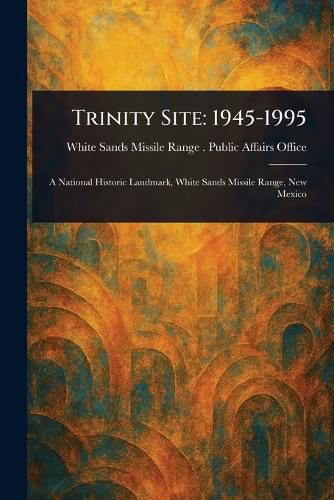Readings Newsletter
Become a Readings Member to make your shopping experience even easier.
Sign in or sign up for free!
You’re not far away from qualifying for FREE standard shipping within Australia
You’ve qualified for FREE standard shipping within Australia
The cart is loading…






This title is printed to order. This book may have been self-published. If so, we cannot guarantee the quality of the content. In the main most books will have gone through the editing process however some may not. We therefore suggest that you be aware of this before ordering this book. If in doubt check either the author or publisher’s details as we are unable to accept any returns unless they are faulty. Please contact us if you have any questions.
"The Trinity Atomic Test Site" offers a compelling historical account of one of the most pivotal moments in human history: the dawn of the atomic age. Compiled by the White Sands Missile Range Public Affairs Office, this meticulously researched volume delves into the story of the Trinity test, conducted in the New Mexico desert. Explore the scientific and logistical challenges of the Los Alamos project, culminating in the first detonation of a nuclear weapon at the White Sands Proving Ground. From the theoretical physics to the practical engineering, witness the convergence of minds and materials that shaped the world. This historical document examines the Trinity test within the broader context of 20th-century United States history, the science of physics, and military technological advancements. A crucial resource for anyone interested in nuclear testing, the atomic bomb, and the legacy of Los Alamos.
This work has been selected by scholars as being culturally important, and is part of the knowledge base of civilization as we know it.
This work is in the public domain in the United States of America, and possibly other nations. Within the United States, you may freely copy and distribute this work, as no entity (individual or corporate) has a copyright on the body of the work.
Scholars believe, and we concur, that this work is important enough to be preserved, reproduced, and made generally available to the public. We appreciate your support of the preservation process, and thank you for being an important part of keeping this knowledge alive and relevant.
$9.00 standard shipping within Australia
FREE standard shipping within Australia for orders over $100.00
Express & International shipping calculated at checkout
This title is printed to order. This book may have been self-published. If so, we cannot guarantee the quality of the content. In the main most books will have gone through the editing process however some may not. We therefore suggest that you be aware of this before ordering this book. If in doubt check either the author or publisher’s details as we are unable to accept any returns unless they are faulty. Please contact us if you have any questions.
"The Trinity Atomic Test Site" offers a compelling historical account of one of the most pivotal moments in human history: the dawn of the atomic age. Compiled by the White Sands Missile Range Public Affairs Office, this meticulously researched volume delves into the story of the Trinity test, conducted in the New Mexico desert. Explore the scientific and logistical challenges of the Los Alamos project, culminating in the first detonation of a nuclear weapon at the White Sands Proving Ground. From the theoretical physics to the practical engineering, witness the convergence of minds and materials that shaped the world. This historical document examines the Trinity test within the broader context of 20th-century United States history, the science of physics, and military technological advancements. A crucial resource for anyone interested in nuclear testing, the atomic bomb, and the legacy of Los Alamos.
This work has been selected by scholars as being culturally important, and is part of the knowledge base of civilization as we know it.
This work is in the public domain in the United States of America, and possibly other nations. Within the United States, you may freely copy and distribute this work, as no entity (individual or corporate) has a copyright on the body of the work.
Scholars believe, and we concur, that this work is important enough to be preserved, reproduced, and made generally available to the public. We appreciate your support of the preservation process, and thank you for being an important part of keeping this knowledge alive and relevant.